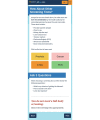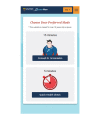A Mobile Web App to Improve Health Screening Uptake in Men (ScreenMen): Utility and Usability Evaluation Study
- PMID: 30985280
- PMCID: PMC6487344
- DOI: 10.2196/10216
A Mobile Web App to Improve Health Screening Uptake in Men (ScreenMen): Utility and Usability Evaluation Study
Abstract
Background: Globally, the uptake of health screening is suboptimal, especially in men and those of younger age. In view of the increasing internet access and mobile phone ownership, ScreenMen, a mobile Web app, was developed to improve health screening uptake in men.
Objective: This study aimed to evaluate the utility and usability of ScreenMen.
Methods: This study used both qualitative and quantitative methods. Healthy men working in a banking institution were recruited to participate in this study. They were purposively sampled according to job position, age, education level, and screening status. Men were asked to use ScreenMen independently while the screen activities were being recorded. Once completed, retrospective think aloud with playback was conducted with men to obtain their feedback. They were asked to answer the System Usability Scale (SUS). Intention to undergo screening pre- and postintervention was also measured. Qualitative data were analyzed using a framework approach followed by thematic analysis. For quantitative data, the mean SUS score was calculated and change in intention to screening was analyzed using McNemar test.
Results: In total, 24 men participated in this study. On the basis of the qualitative data, men found ScreenMen useful as they could learn more about their health risks and screening. They found ScreenMen convenient to use, which might trigger men to undergo screening. In terms of usability, men thought that ScreenMen was user-friendly and easy to understand. The key revision done on utility was the addition of a reminder function, whereas for usability, the revisions done were in terms of attracting and gaining users' trust, improving learnability, and making ScreenMen usable to all types of users. To attract men to use it, ScreenMen was introduced to users in terms of improving health instead of going for screening. Another important revision made was emphasizing the screening tests the users do not need, instead of just informing them about the screening tests they need. A Quick Assessment Mode was also added for users with limited attention span. The quantitative data showed that 8 out of 23 men (35%) planned to attend screening earlier than intended after using the ScreenMen. Furthermore, 4 out of 12 (33%) men who were in the precontemplation stage changed to either contemplation or preparation stage after using ScreenMen with P=.13. In terms of usability, the mean SUS score of 76.4 (SD 7.72) indicated that ScreenMen had good usability.
Conclusions: This study showed that ScreenMen was acceptable to men in terms of its utility and usability. The preliminary data suggested that ScreenMen might increase men's intention to undergo screening. This paper also presented key lessons learned from the beta testing, which is useful for public health experts and researchers when developing a user-centered mobile Web app.
Keywords: eHealth; health behavior; internet; mHealth; mass screening; men’s health.
©Chin Hai Teo, Chirk Jenn Ng, Sin Kuang Lo, Chip Dong Lim, Alan White. Originally published in JMIR Mhealth and Uhealth (http://mhealth.jmir.org), 15.04.2019.
Conflict of interest statement
Conflicts of Interest: None declared.
Figures





Similar articles
-
Usability and Usefulness of a Mobile Health App for Pregnancy-Related Work Advice: Mixed-Methods Approach.JMIR Mhealth Uhealth. 2019 May 9;7(5):e11442. doi: 10.2196/11442. JMIR Mhealth Uhealth. 2019. PMID: 31094353 Free PMC article.
-
What Do Men Want from a Health Screening Mobile App? A Qualitative Study.PLoS One. 2017 Jan 6;12(1):e0169435. doi: 10.1371/journal.pone.0169435. eCollection 2017. PLoS One. 2017. PMID: 28060953 Free PMC article.
-
Usability and User Experience Testing of a Co-Designed Electronic Patient-Reported Outcomes App ("MyPal for Adults") for Palliative Cancer Care: Mixed Methods Study.JMIR Hum Factors. 2025 Apr 24;12:e57342. doi: 10.2196/57342. JMIR Hum Factors. 2025. PMID: 40278640 Free PMC article.
-
Methods of usability testing in the development of eHealth applications: A scoping review.Int J Med Inform. 2019 Jun;126:95-104. doi: 10.1016/j.ijmedinf.2019.03.018. Epub 2019 Mar 31. Int J Med Inform. 2019. PMID: 31029270
-
Perceptions of Smartphone User-Centered Mobile Health Tracking Apps Across Various Chronic Illness Populations: An Integrative Review.J Nurs Scholarsh. 2017 Jul;49(4):371-378. doi: 10.1111/jnu.12298. Epub 2017 Jun 12. J Nurs Scholarsh. 2017. PMID: 28605151 Review.
Cited by
-
Sociodemographic Characteristics Associated With an eHealth System Designed to Reduce Depressive Symptoms Among Patients With Breast or Prostate Cancer: Prospective Study.JMIR Form Res. 2022 Jun 8;6(6):e33734. doi: 10.2196/33734. JMIR Form Res. 2022. PMID: 35675116 Free PMC article.
-
Are sex disparities in COVID-19 a predictable outcome of failing men's health provision?Nat Rev Urol. 2022 Jan;19(1):47-63. doi: 10.1038/s41585-021-00535-4. Epub 2021 Nov 18. Nat Rev Urol. 2022. PMID: 34795426 Free PMC article. Review.
-
Interactive Malaysian Childhood Healthy Lifestyle (i-MaCHeL) programme: a single-arm pilot study.Pilot Feasibility Stud. 2024 May 18;10(1):80. doi: 10.1186/s40814-024-01483-7. Pilot Feasibility Stud. 2024. PMID: 38762727 Free PMC article.
-
Designing Survey-Based Mobile Interfaces for Rural Patients With Cancer Using Apple's ResearchKit and CareKit: Usability Study.JMIR Form Res. 2024 Sep 26;8:e57801. doi: 10.2196/57801. JMIR Form Res. 2024. PMID: 39326043 Free PMC article.
-
Promoting Men's Health With the "Don't Change Much" e-Program.Am J Mens Health. 2021 Mar-Apr;15(2):15579883211001189. doi: 10.1177/15579883211001189. Am J Mens Health. 2021. PMID: 33745369 Free PMC article.
References
-
- GSM. 2018. [2018-03-16]. The Mobile Economy 2018 https://www.gsma.com/mobileeconomy/wp-content/uploads/2018/02/The-Mobile... .
-
- van den Berg MH, Schoones JW, Vliet VT. Internet-based physical activity interventions: a systematic review of the literature. J Med Internet Res. 2007;9(3):e26. doi: 10.2196/jmir.9.3.e26. http://www.jmir.org/2007/3/e26/ v9i3e26 - DOI - PMC - PubMed
-
- Wantland DJ, Portillo CJ, Holzemer WL, Slaughter R, McGhee EM. The effectiveness of web-based vs non-web-based interventions: a meta-analysis of behavioral change outcomes. J Med Internet Res. 2004 Nov 10;6(4):e40. doi: 10.2196/jmir.6.4.e40. http://www.jmir.org/2004/4/e40/ v6e40 - DOI - PMC - PubMed
-
- Välimäki M, Anttila K, Anttila M, Lahti M. Web-based interventions supporting adolescents and young people with depressive symptoms: systematic review and meta-analysis. JMIR Mhealth Uhealth. 2017 Dec 8;5(12):e180. doi: 10.2196/mhealth.8624. http://mhealth.jmir.org/2017/12/e180/ v5i12e180 - DOI - PMC - PubMed
Publication types
MeSH terms
LinkOut - more resources
Full Text Sources

